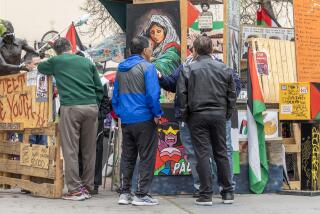PERSPECTIVE ON THE CHICANO UPRISING : Derailed Then, Make History Now : Latinos have learned and endured enough in 20 years to start asking hard questions about the persistence of repression.
- Share via
Earlier this month, the African-American community in Los Angeles observed the 25th anniversary of the Watts uprising. This week, the Latino community is observing the 20th anniversary of the National Chicano Moratorium. The two events had similarities whose significance seems to have been lost over the intervening years. Each emerged as a community’s legitimate protest against oppressive socioeconomic and political conditions--which today stand far from being addressed as we had hoped two decades ago.
For example, in 1969, the median income of a Mexican-American family in Los Angeles was 29% below the statewide median; 16.7% lived below the poverty line; 75% of our housing stock was more than 20 years old, and only 29% of it was considered sound. Today, the median family income for Chicanos is only 62% of that earned by white families nationally, while 28% of us live below the poverty line.
For us Chicanos, the experience of Watts five years earlier was inspiring. It represented the determination of an oppressed people to fight the system and shed the yoke of racism. Little did we know that what happened in Watts had sanctioned the police apparatus’ wide use of “safeguards” to ensure that an uprising of that magnitude would never be repeated here.
The spark that unleashed the violence in both communities was caused by the same source: conflict with a racist law enforcement system.
The height of our mass protest came during the National Chicano Moratorium, on Aug. 29, 1970, when more than 20,000 of us marched in East L.A. to protest the war in Vietnam and the disproportionately high casualty rates for Chicano troops at a time when we were denied equality at home. It was against this political climate that, when the march peacefully assembled for a rally in Laguna Park, 1,500 law officers tear-gassed and indiscriminately beat children, women and men under the excuse that shoplifting and bottle-throwing had occurred 1 1/2 blocks away. By day’s end, three Chicanos had been killed and hundreds injured, and more than 400 had been arrested.
The violent suppression not only altered the course of the Chicano movement; it significantly derailed it. It turned our organizing, spirit and energy away from anti-war efforts and focused our attention on the issue of police brutality and unequal justice (which still consumes too much of our time).
In the immediate aftermath of both the Watts and the Chicano uprisings, official commissions issued reports that focused on the violence that occurred rather than the reasons for the protest; both reports adopted a “blaming the victim” mentality. In our case, that attempt to distort the truth largely centered on the official justification that excessive force had been used because of moratorium organizers’ presumed links to leftist and “communist” groups.
What have we learned after 20 years? Well, we are keenly aware that history is made twice: in the actual unfolding of events and in the interpretation and recording of those events. It is the latter that is the most important if we are to survive as a people.
To this end, history has been more kind in the recording of Watts. A book has been published, a major conference has been held, and the media have done cover stories, special sections and long analyses.
Not so for the National Chicano Moratorium. No book has been written, no in-depth analyses have been published. The Los Angeles Times has only run articles commemorating its columnist, Ruben Salazar, who was murdered that day when a 10-inch tear-gas projectile was fired into his skull by a sheriff’s deputy. Despite evidence of a cover-up and a coroner’s jury finding that Salazar had died “at the hands of another,” the Sheriff’s Department was exonerated of wrongdoing.
Twenty years later, we are better equipped to interpret and record the history. It has taken us 20 years, but we have learned that the extensive police-state apparatus that was created to stifle our movement in 1970 was part and parcel of the open repression that was used against Dr. Martin Luther King Jr. and the African-American quest for equality.
Twenty years later, we understand that the repressive actions used against us on Aug. 29, 1970, were essentially no different from those that historically have been used to silence people--particularly prominent critics--struggling for justice anywhere. Ruben Salazar was one who had begun to suspect he would be silenced, but he never thought it would take murder to do so.
In a society afflicted with historical amnesia, we should begin by correcting the record. The first step in this historical healing is demanding a reopening of the investigation into the murder of Ruben Salazar. The answers to many questions we have asked ourselves for 20 years are lying in sealed vaults. Twenty years have passed, and now we are better equipped to make history in the second round.
More to Read
Sign up for Essential California
The most important California stories and recommendations in your inbox every morning.
You may occasionally receive promotional content from the Los Angeles Times.










